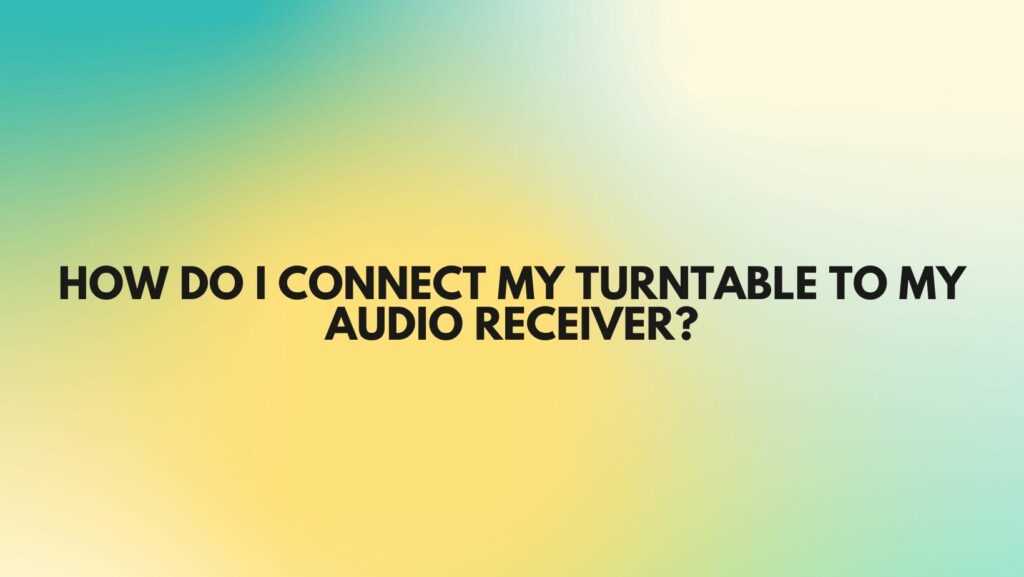Vinyl records have made a remarkable comeback in recent years, offering a unique and warm analog sound that many audiophiles and music enthusiasts cherish. If you own a turntable and want to enjoy your vinyl collection through your audio receiver, you’ll need to know how to make the proper connections. In this comprehensive guide, we will walk you through the steps to connect your turntable to your audio receiver and ensure you get the best possible sound quality.
Equipment You’ll Need
Before we delve into the step-by-step process, let’s first make sure you have all the necessary equipment ready:
- Turntable: This is your vinyl record player. Make sure it’s in good working condition.
- Audio Receiver: Your audio receiver is responsible for amplifying the signal from your turntable and routing it to your speakers.
- Phono Preamp: Most turntables require a phono preamp to boost the signal from the cartridge. Some audio receivers have a built-in phono stage, so check if you need an external preamp.
- RCA Cables: You’ll need a pair of RCA cables to connect the turntable to the phono preamp and another pair to connect the phono preamp to the audio receiver.
- Speakers: Ensure you have speakers connected to your audio receiver.
Step 1: Setting Up the Turntable
- Place your turntable on a sturdy and level surface.
- Ensure the turntable is properly balanced, and the tonearm is not skipping or dragging across the record.
- Install the cartridge (the part that holds the stylus or needle) according to the manufacturer’s instructions.
- Set the turntable to the correct speed (usually 33⅓ or 45 RPM) for the record you want to play.
Step 2: Connecting the Turntable to the Phono Preamp
- Locate the phono output on your turntable. It may be labeled as “PHONO OUT” or “LINE OUT.”
- Connect one end of the RCA cable to the phono output on the turntable.
- Connect the other end of the RCA cable to the input of the phono preamp.
- If your turntable has a ground wire, attach it to the grounding post on the phono preamp. This helps reduce unwanted noise and hum.
Step 3: Connecting the Phono Preamp to the Audio Receiver
- Connect a second pair of RCA cables from the output of the phono preamp to an available input on your audio receiver. This input is often labeled as “PHONO,” “AUX,” or “LINE IN.”
- Make sure you connect the left (white) cable to the left input and the right (red) cable to the right input.
Step 4: Configuring the Audio Receiver
- Turn on your audio receiver and select the input you used to connect the phono preamp. This is usually done by turning the input selector knob on the front of the receiver or using a remote control.
- Depending on your audio receiver, you may need to adjust the input settings for the phono input. Some receivers have a built-in phono stage, while others do not. If your receiver has a phono stage, select “Phono” on the input selector. If it doesn’t, select “AUX” or “LINE IN.”
- Set the correct EQ curve for vinyl records, typically the RIAA curve. Most modern audio receivers have this setting built-in, but if not, consider an external EQ.
Step 5: Testing and Fine-Tuning
- Carefully lower the tonearm onto a vinyl record.
- Listen to the sound. If the audio is too quiet or distorted, adjust the volume on the audio receiver.
- Make fine adjustments to the turntable’s tracking force and anti-skate settings to ensure proper tracking and sound quality.
- Ensure the stylus is clean and in good condition to prevent damage to your records.
Conclusion
Connecting your turntable to your audio receiver is a straightforward process that allows you to enjoy the warm and authentic sound of vinyl records. With the right equipment and proper setup, you can relish the analog music experience that vinyl offers. Take your time to set up your turntable correctly, and you’ll be able to enjoy your vinyl collection for years to come.


